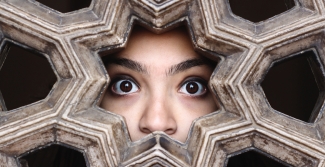Blepharitis: The causes, symptoms and treatments
What's itchy and red all over? The inflamed eyelids of someone suffering from blepharitis – and it's no joke.
Blepharitis is a common condition which can develop at any age and, if left untreated, can last for years and recur unless the person adopts a consistent program of eye hygiene. Eyecare professionals report that 40 per cent of patients have experienced it, and many of them are contact lens wearers.
The problem
So, what is blepharitis exactly? Blepharitis is an inflammation along the rims of the eyelids where eyelashes grow. The skin around the eyes becomes irritated and is often red and itchy. You may notice dry scales that stick to your eyelashes. Although this is not a form of infection, it is usually caused by naturally occurring bacteria that live on our skin.
Blepharitis can impact the amount of lubrication in your eyes, which can be problematic for anyone, particularly those who wear contact lenses.
Though it's unpleasant, the good news is that it's treatable!
What are the causes of blepharitis?
Blepharitis is related to dandruff but is also associated with the following:
- Bacteria
- Rosacea (facial redness)
- Allergic reaction (from makeup, contact lens solutions or eye medication)
- Clogged oil glands in the eyelid
- Lice or mites in the eyebrows

What are the symptoms of blepharitis?
The signs of blepharitis are readily apparent, so you're not likely to miss them.
Here's what to watch for:
- Redness: Eyes are likely red and swollen
- Grittiness: Eyelids may be irritated and itchy, and your eyes may feel like they have sand in them
- Gloopy eyes: Though encrusted, the eyelids may feel greasy. It's also not unusual to wake up with your eyelids stuck together
- Flaking: The skin surrounding the eye will likely be flaky, with eyelashes either falling out or growing in different directions
- Blinking: You'll be more sensitive to light and find yourself blinking more often
Potential complications
Blepharitis can also lead to other problems, such as:
- Styes: Caused by infected lash follicles, styes are sensitive lumps on the outside of the eyelid
- Cysts/Chalazions: These are swollen lumps on the inside of the eyelid caused by infected oil glands
- Dry eye: This condition results from tears providing insufficient lubrication to your eyes. It often occurs in tandem with blepharitis, making eyecare practitioners sometimes wonder which comes first and leads to the other
- Conjunctivitis: Also known as pink eye, this condition is an inflammation of the conjunctiva — the mucous membrane that lines the inside of your eyelids and the front of your eyes

How to treat blepharitis
Many cases of blepharitis can be treated at home with guidance from your optician. It's important to consistently follow your regimen, which may include a variety of treatments to keep the condition under control, such as:
- Hot compresses with a flannel or microwavable bag (37 degrees Celsius) for up to 3 mins (careful not to burn your skin). This needs to be followed by gently massaging the lids using your index finger in order to help the oil glands from blocking up, which can lead to chalazions.
- Lid scrubs or specially formulated gel, used daily, to keep the eyelids clean of build-up and debris.
Further treatment for advanced blepharitis
In cases of advanced blepharitis, usually when linked to underlying causes (such as rosacea, for example), prescribed treatment may be in order, such as:
- In-office procedures performed by a professional
- Antibiotic ointments, creams and oral medications
- Eyedrops (usually steroids) to help reduce the inflammation
The NHS has further information here https://www.nhs.uk/conditions/blepharitis/
Next steps
Good hygiene and hot compress treatments are essential as they can help prevent the issue and reduce the likelihood of symptoms returning. It is recommended to carry on with the treatment plan, even when the condition appears to be under control.
If you're a contact lens wearer, we understand that you'll want to get back in your contacts as soon as possible. Practising good hygiene and using lid scrubs to clean your eyelids daily can reduce the recurrence of blepharitis. Some opticians also suggest supplements such as Omega-3 fatty acids.
Whatever your regimen, make it part of your daily routine. Once you're ready to return to contact lens wear, daily disposable lenses might be the best option to lower your risk of experiencing any future problems. Thankfully, for most wearers, they're also the most comfortable and convenient form of vision correction. Always check with your optician which lenses are best for you and your eye health.








